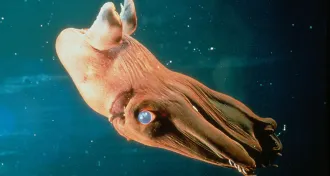Life
Sign up for our newsletter
We summarize the week's scientific breakthroughs every Thursday.
-
 Life
LifeAll dinosaurs may have had feathers
Well-preserved fossil sports long, fine plumage and a bushy tail.
By Meghan Rosen -
 Animals
AnimalsClimate adaptation may be a family affair
Newborn coral reef fish can cope with changed water conditions if their parents have already adjusted.
By Janet Raloff -
 Animals
AnimalsMosquitoes Remade
Scientists reinvent agents of illness to become allies in fight against disease.
By Susan Milius -
 Genetics
GeneticsConvenience shoulders tomato taste aside
Decades of breeding for uniform color in unripe fruit may accidentally have reduced flavor.
By Susan Milius -
 Animals
AnimalsDinosaur debate gets cooking
A key piece of evidence for cold-blooded dinosaurs, growth lines in bones, has also been discovered in a set of warm-blooded animals.
By Meghan Rosen -
 Humans
HumansLead poisoning stymies condor recovery
California’s iconic comeback species may need human help as long as even a small percentage of the carcasses they eat contain lead shot.
By Susan Milius -

-
 Life
LifeSecond of two blocked flu papers released
Held back for months by a U.S. government biosafety board, the research pinpoints five mutations that render the potent H5N1 virus transmissible through air.
-
 Life
LifeNew frontiers for coyotes may bring more Lyme disease
Forget the deer. Maybe it's coyotes on the move that can explain the recent increase in Lyme disease.
By Susan Milius -
 Life
LifePeacocks ruffle feathers, make a rumble
New recordings reveal that male birds use infrasound, emitting low-pitch sounds detected by peers but inaudible to human ears.
By Susan Milius -
 Life
LifeChicks do worse in noisy nests
Baby bluebirds, and their parents, appear to have trouble communicating over the racket made by nearby humans.
By Susan Milius -
 Ecosystems
EcosystemsChanging seasons inspire science
Researchers are tapping into the wealth of observations being made by citizen scientists nationwide. One of the largest repositories of such data is maintained by the USA National Phenology Network.
By Sid Perkins